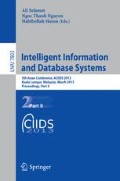Abstract
Social scientists have identified several network relationships and dimensions that induce homophily. Sentiments or opinions towards different issues have been observed as a key dimension which characterizes human behavior. Twitter is an online social medium where rapid communication takes place publicly. People usually express their sentiments towards various issues. Different persons from different walks of social life may share same opinion towards various issues. When these persons constitute a group, such groups can be conveniently termed same wavelength groups. We propose a novel framework based on sentiments to identify such same wavelength groups from twitter domain. The analysis of such groups would be of help in unraveling their response patterns and behavioral features.
Access this chapter
Tax calculation will be finalised at checkout
Purchases are for personal use only
Preview
Unable to display preview. Download preview PDF.
References
Abbasi, M.A., Chai, S.K., Liu, H., Sagoo, K.: Real-World Behavior Analysis through a Social Media Lens. In: Yang, S.J., Greenberg, A.M., Endsley, M. (eds.) SBP 2012. LNCS, vol. 7227, pp. 18–26. Springer, Heidelberg (2012)
Adams, J., Faust, K., Lovasi, G.S.: Capturing context: Integrating spatial and social network analyses. Social Networks 34(1), 1–5 (2012)
Benevenuto, F., Rodrigues, T.: Characterizing user behavior in online social networks. In: Proceedings of the 9th ACM SIGCOMM Conference on Internet Measurement Conference, NY, USA, pp. 49–62 (2009)
Bifet, A., Frank, E.: Sentiment Knowledge Discovery in Twitter Streaming Data. In: Pfahringer, B., Holmes, G., Hoffmann, A. (eds.) DS 2010. LNCS (LNAI), vol. 6332, pp. 1–15. Springer, Heidelberg (2010)
Bollen, J., Mao, H., Zeng, X.: Twitter mood predicts the stock market. Journal of Computational Science 2(1), 1–8 (2011)
Bollen, J., Pepe, A.: Modeling Public Mood and Emotion: Twitter Sentiment and Socio-Economic Phenomena. In: Fifth International AAAI Conference on Weblogs and Social Media, pp. 450–453 (2011)
Davidov, D., Tsur, O., Rappoport, A.: Enhanced sentiment learning using twitter hashtags and smileys. In: Proceedings of the 23rd International Conference on Computational Linguistics: Posters, PA, USA, pp. 241–249 (2010)
Guo, L., Tan, E., Chen, S., Zhang, X., Zhao, Y.E.: Analyzing patterns of user content generation in online social networks. In: Proceedings of the 15th ACM SIGKDD International Conference on Knowledge Discovery and Data Mining, KDD 2009, pp. 369–378 (2009)
Jiang, J., Wilson, C., Wang, X., Huang, P., Sha, W., Dai, Y., Zhao, B.Y.: Understanding latent interactions in online social networks. In: Proceedings of the 10th Annual Conference on Internet Measurement, IMC 2010, pp. 369–382 (2010)
Jiang, L., Yu, M., Zhou, M.: Target-dependent twitter sentiment classification. In: 49th Annual Meeting of the Association for Computational Linguistics, Oregon, pp. 151–160 (June 2011)
Lewis, K., Kaufman, J., Gonzalez, M., Wimmer, A., Christakis, N.: Tastes, ties, and time: A new social network dataset using Facebook.com. Social Networks 30(4), 330–342 (2008)
Mcpherson, M., Smith-lovin, L., Cook, J.M.: Birds of a Feather: Homophily in Social Networks. Annual Review of Sociology 27(1), 415–444 (2001)
Moore, K., McElroy, J.C.: The influence of personality on Facebook usage, wall postings, and regret. Computers in Human Behavior 28(1), 267–274 (2012)
O’Connor, B.: From tweets to polls: Linking text sentiment to public opinion time series. In: Proceedings of the International AAAI Conference on Weblogs and Social Media, Washington, DC, pp. 122–129 (2010)
Palla, G., Derényi, I., Farkas, I., Vicsek, T.: Uncovering the overlapping community structure of complex networks in nature and society. Nature 435(7043), 814–818 (2005)
Panigrahy, R., Najork, M., Xie, Y.: How user behavior is related to social affinity. In: Proceedings of the Fifth ACM International Conference on WSDM 2012, Washington, pp. 713–722 (2012)
Sachan, M., Contractor, D., Faruquie, T.A., Subramaniam, L.V.: Using content and interactions for discovering communities in social networks. In: Proceedings of the 21st International Conference on World Wide Web, WWW 2012, pp. 331–340 (2012)
Tan, C., Lee, L., Tang, J., Jiang, L., Zhou, M., Li, P.: User-level sentiment analysis incorporating social networks. In: ACM International Conference on Knowledge and Data Engineering (KDD 2011), California, USA, pp. 1397–1405 (2011)
Tang, L., Liu, H.: Relational learning via latent social dimensions. In: Proceedings of the 15th ACM SIGKDD International Conference on Knowledge Discovery and Data Mining, KDD 2009, pp. 817–825 (2009)
Tang, L., Liu, H.: Toward Collective Behavior Prediction via Social Dimension Extraction. IEEE Intelligent Systems 25(6), 19–25 (2010)
Tang, L., Wang, X., Liu, H.: Scalable learning of collective behavior. Knowledge and Data Engineering 24(6), 1080–1091 (2012)
Wang, C., Huberman, B.A.: How Random are Online Social Interactions? Scientific Reports 2, 633–638 (2012)
Wang, X., Tang, L., Gao, H., Liu, H.: Discovering Overlapping Groups in Social Media. In: 2010 IEEE International Conference on Data Mining, pp. 569–578 (December 2010)
Yang, X., Steck, H., Liu, Y.: Circle-based recommendation in online social networks. In: Proceedings of the 18th ACM SIGKDD International Conference on Knowledge Discovery and Data Mining, pp. 1267–1275 (2012)
Author information
Authors and Affiliations
Editor information
Editors and Affiliations
Rights and permissions
Copyright information
© 2013 Springer-Verlag Berlin Heidelberg
About this paper
Cite this paper
Pandara, R., Sendhilkumar, S. (2013). Identifying Same Wavelength Groups from Twitter: A Sentiment Based Approach. In: Selamat, A., Nguyen, N.T., Haron, H. (eds) Intelligent Information and Database Systems. ACIIDS 2013. Lecture Notes in Computer Science(), vol 7803. Springer, Berlin, Heidelberg. https://doi.org/10.1007/978-3-642-36543-0_8
Download citation
DOI: https://doi.org/10.1007/978-3-642-36543-0_8
Publisher Name: Springer, Berlin, Heidelberg
Print ISBN: 978-3-642-36542-3
Online ISBN: 978-3-642-36543-0
eBook Packages: Computer ScienceComputer Science (R0)

